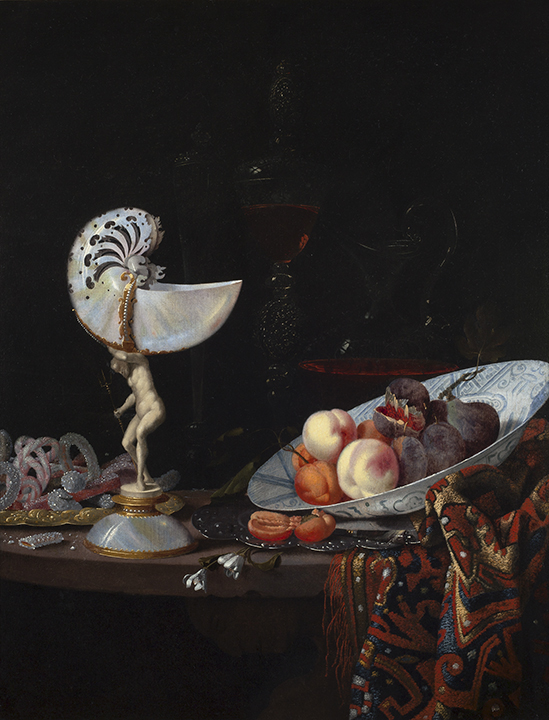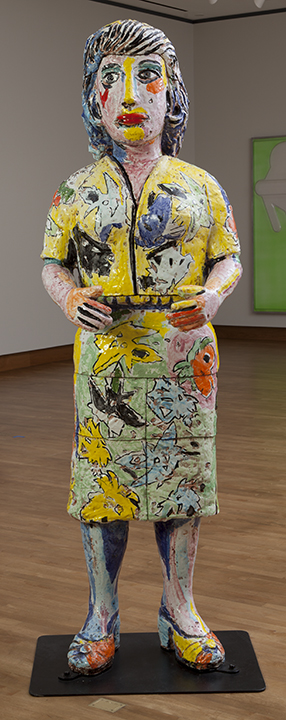 While the museum is closed, we’ve asked our docents to take us on “virtual docent’s tours,” showing us digitally some of their favorite works. Jeanne Ferreira has been a docent for more 10 years, and talk about some of some of the works of art she regularly discusses while giving tours.
While the museum is closed, we’ve asked our docents to take us on “virtual docent’s tours,” showing us digitally some of their favorite works. Jeanne Ferreira has been a docent for more 10 years, and talk about some of some of the works of art she regularly discusses while giving tours.
How did you become interested in becoming a docent?
I grew up in a family of artists and I am also an artist. There is nothing that makes me happier, calmer or more meditative than being around art.
When you’re conducting a tour of the permanent galleries, which pieces do you always show your guests?
I love to introduce visitors to Still Life with Nautilus Cup and Fruit by Georg Hainz and, of course, most of my guests want to stop and talk about Reflective Woman II by Viola Frey, especially because she is now in the lobby.
Why do you include these particular pieces in your tours?
I focus on Still Life with Nautilus Cup and Fruit because I can talk about art from the Christian Era to the Baroque, which affords me an opportunity to chat about different eras of art. I also love it because the hidden figure in the piece is so intriguing to young and older guests alike.
I include Reflective Woman II because I love Viola Frey’s story. I’m from California and her story resonates with me. Also, I enjoy having my guests express their opinion about whether our woman is happy or sad, as well as discussing her use of color.
What do you usually tell guests about this piece/these pieces?
Georg Hainz, (German, 1630/1631-1670/1700), Still Life with Nautilus Cup and Fruit, n.d., Oil on canvas, 38 1/16 x 29 5/8 in., Gift of Mr. and Mrs. Marc B. Rojtman, 62.1.1
For Still Life with Nautilus Cup and Fruit, we talk about the abundance of wealth and how it is represented by the items in the painting. Additionally, we discuss what that wealth meant in that time. I discuss the role of the merchant seaman and the presence of the hidden figure, and often ask guests for their take on why the figure is present. My approach is not to say anything about the figure when we first approach the painting, but rather to ask them to look at the painting and then close their eyes. When they reopen their eyes, I ask them, “What do you see that you did not see before?” Children see the hidden figure much quicker than adults, but I believe that’s because at their height they are looking toward the bottom of the painting.
Viola Frey, (American, 1933-2004), Reflective Woman II, 2002, Ceramic with glaze, 91 1/2 x 28 x 23 in., Gift of Simona and Jerome Chazen, 2012.5.2a-i
When I’m showing off Reflective Woman II, my first question to them is “Is this woman happy or sad?” I will ask children to strike the pose of the woman and see if that changes their assessment. We then discuss the height of the woman, and I explain that Viola Frey was diminutive in stature and, growing up in Lodi, California, she was too short to see over the grape vines. Thus, she made all her sculptures large, so they were never in the same situation. Also, I discuss the clothing the subject is wearing. Growing up in a farm community where the workers would walk to church on Sunday, the dress is an homage to all the women.
Construction of the piece can also be part of my presentation—how she is shipped, her cement shoes etc. I also carry photos of other Viola Frey sculptures that I have seen in San Francisco or Tucson or elsewhere.
How do guests typically react to your must-sees?
Students love Still Life because they solve a mystery. Although I have one professor who brings her class every year and always asks me to include that painting, discovery is always rewarding.
When it comes to Reflective Woman II, typically people are fascinated by the fact that while one person will see the figure as joyful, others find her unsettling. They love it when they see the “tear” on her cheek, because they feel they know the emotion she feels. When they strike the pose, they often change their mind about the emotions of the figure.
Is there anything you’d like to pass along to readers in this difficult time about art and the solace it can provide, or about the Chazen in general?
At difficult times such as these, our society turns to the arts for solace. Find a piece of art that speaks to you and study it; it can help uncover emotions and hopefully bring peace to your soul.

